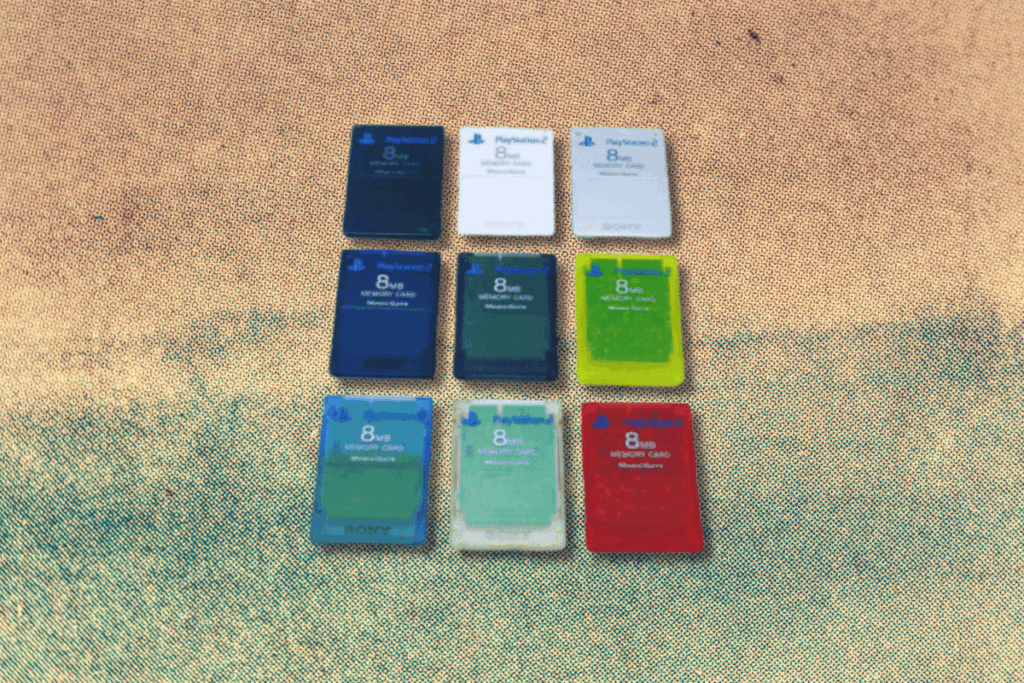There’s a specific kind of panic that only gamers of a certain age understand. That moment when you turn on your console, navigate to load your game, and see those words that made your heart drop: “Memory card data is corrupted.”

If you grew up in the PS1, PS2, or original Xbox era, you know this pain. You know it intimately. That little piece of plastic held your entire gaming life, and when it failed, it didn’t just delete data—it deleted hours of your life.
The Anxiety Was Real
Remember how careful you were around that save icon? That little symbol in the corner of the screen that meant the game was writing to your memory card? You wouldn’t dare touch anything. You held your breath. You didn’t move. One wrong button press, one accidental console bump, one power interruption, and everything could be gone.
“Do not remove memory card or turn off console” wasn’t just a warning—it was a commandment. We treated those moments with religious reverence. Parents learned quickly that interrupting during a save was grounds for legitimate distress.
And if the power went out during a save? That was it. You’d restart your console with actual fear in your heart, praying to every gaming deity that your file survived. Sometimes it did. Sometimes you lost everything. Sometimes you lost just that one specific save, which somehow felt worse—like the universe was specifically targeting your 50-hour RPG run while leaving your 2-hour racing game untouched.
The Math of Limited Space
8MB. That’s what you got on a standard PS2 memory card. Eight megabytes to hold your entire gaming existence. You had to make choices. Strategic, painful choices.

Which save files were worth keeping? Could you delete that old game you finished months ago, or would you suddenly want to replay it? Do you keep multiple save slots for one game, or risk it all on a single save? Every block mattered. Every kilobyte counted.
Filipino gamers know this struggle extra well. Not everyone could just buy another memory card. If you had one, you made it work. You became an expert at save file management, deleting and reorganizing like you were running a digital archive on a budget.
The worst feeling? Getting a new game you were hyped about, only to discover it needed more blocks than you had available. Then came the agonizing process of deciding what to sacrifice. Goodbye, 60-hour Final Fantasy save. Hello, brand new game that better be worth it.
That One Friend With Multiple Memory Cards
Every friend group had that kid. The one whose parents didn’t question their gaming expenses. The one who had different memory cards color-coded by genre. Racing games on blue. RPGs on red. Action games on black.

The rest of us looked at them like they were living in luxury. Because they were. Multiple memory cards meant no compromises. No deleting. No anxiety. Just pure, unlimited save file freedom.
And if you were lucky enough to be friends with that person? They’d let you borrow a memory card to bring your save file over for multiplayer sessions. You’d guard that borrowed card with your life during the commute to their house. That card held their gaming history—losing it would end the friendship.
The Trading and Borrowing Economy
Speaking of borrowing, memory cards created their own economy. You’d lend someone your game, but you’d keep your memory card. That was yours. That was sacred. The game was just plastic and circuits; the memory card held your achievements, your progress, your identity as a gamer.
Sometimes you’d borrow a friend’s memory card specifically to see their progress. “Wait, you beat Metal Gear Solid without being detected? Let me see your save file.” It was proof. It was bragging rights made tangible.
Memory cards also facilitated a unique form of showing off. You couldn’t just screenshot your achievement or stream your victory. You had to physically bring your memory card to prove you’d beaten that impossible boss or unlocked that secret character. Your save file was your receipt.
When Corruption Struck
Let’s talk about the real trauma—data corruption. Not from your fault. Not from a power outage. Just random, cruel, technical failure.
You’d turn on your PS2, and instead of your save file list, you’d get an error. “Unformatted memory card” or “Corrupted data.” Your stomach would drop. You’d try everything. Turn it off and on. Blow on the contacts (we all did it, even though it didn’t help). Try it in different games. Pray.
Sometimes reformatting would fix it, but that meant losing everything. Sometimes the card was just dead. Months or years of progress, gone. Not because you did anything wrong, but because technology failed you.
The forums were full of desperate posts. “My memory card corrupted, is there any way to save it?” People would share folk remedies and technical workarounds. Some worked. Most didn’t. The pain was universal.
The Specific Games That Hurt Most to Lose
Losing a save file always hurt, but some losses cut deeper than others.
RPG saves were devastating. Final Fantasy X with 80 hours invested. Kingdom Hearts with everything unlocked. Persona 3 where you’d maxed all your social links. Those weren’t just save files—they were time investments that felt like part of your life story.
Sports and wrestling game CAWs (Create-A-Wrestler) hurt in a different way. You’d spent hours crafting the perfect custom character, tuning every stat, designing every detail. That character felt like yours. Losing it felt like losing something you’d created, not just something you’d played.
GTA San Andreas with 100% completion was probably the most painful loss in gaming history. All those territories controlled. All those collectibles found. All those missions completed. Gone. And you knew you’d never have the time or willpower to do it all again.
The Paranoia It Created
Memory card anxiety shaped how we played games. We learned to be paranoid, and that paranoia was justified.
Multiple save slots became mandatory. Never just one save. Always at least two, preferably three. Save in different slots. Alternate your saves. If one corrupts, you’d only lose a little progress instead of everything.
We developed rituals. Save at specific points. Save after major achievements. Save before risky moves. Some of us saved so frequently it became a tic. Better safe than sorry became our gaming mantra.
And we learned to back up important saves by copying them to a second memory card if we had one. That’s how valuable these were. We created our own redundancy systems before we even knew what that term meant.
The Physical Object Had Meaning
Here’s something modern gaming lost: the physical representation of your progress. Your memory card was tangible proof of your gaming life. You could hold it. Look at it. Take it with you.
Memory cards got beaten up. Scratched. Label stickers half-peeled off. But they were yours. That wear and tear was earned. That card went to friends’ houses, survived moves, lived in pockets and backpacks. It was a physical diary of your gaming journey.
Some people wrote on them with markers—their name, their PSN ID before PSN existed, little doodles. They personalized these little rectangles of plastic because they mattered. They weren’t just storage; they were part of the gaming identity.
Finding an old memory card years later was like finding a time capsule. You’d plug it in wondering what you’d find. Old saves from games you’d forgotten about. Evidence of who you were as a gamer years ago. It was archaeology, but for your own past.
The Technical Limitations We Worked Around
8MB sounds like nothing now. Your phone probably takes photos bigger than that. But we made it work because we had to.
Game developers had to be creative too. They compressed save data. They limited what could be saved. Some games’ save files were massive (looking at you, Gran Turismo), and we had to plan around them.
Third-party memory cards promised more space—16MB, 32MB, even 64MB cards existed. They were sketchy. They advertised too good to be true capacities. Sometimes they worked. Sometimes they corrupted even faster than official cards. But desperate gamers tried them anyway because official cards were expensive and space was precious.
The PlayStation 2’s memory card management screen became oddly familiar. That UI for copying, deleting, and organizing files was something we all knew by heart. It was like a second operating system we had to master.
When Cloud Saves Changed Everything
Modern consoles auto-save to the cloud. Your progress is backed up automatically. You can access your saves from any console. If your hardware fails, your saves survive. It’s objectively better in every way.
But something was lost. The stakes are lower now. You can’t really lose your progress anymore unless you specifically try to. There’s no more anxiety, but there’s also no more relief when a save completes successfully. No more triumph in successfully managing limited space.
Cloud saves are convenient and safe, but they’re not yours in the same way. You can’t hold them. You can’t bring them to a friend’s house in your pocket. They’re just data floating somewhere, automatically managed, invisible.
The Lessons We Learned
The memory card era taught us things. It taught us resource management—how to make hard choices with limited space. It taught us the value of backups, even if our backups were just multiple save slots. It taught us that technology can fail, and preparation matters.
It taught us to value our progress because we knew it could disappear. Every completed game felt more meaningful because we’d successfully protected that save file from corruption, accidental deletion, or technical failure.
We learned to be careful. To pay attention. To respect the save process. These might seem like small lessons, but they shaped how many of us approach not just gaming, but digital life in general.
The Specific Memory Card Moments We All Shared

Starting a new game and seeing “No memory card inserted” was always a minor crisis. Do you play anyway and lose progress, or do you stop and find your card first? (The answer was always stop and find it.)
The sound of the memory card clicking into the slot. Oddly satisfying.
That one time you accidentally formatted your card instead of a single save file. Pure horror.
Lending someone your game and very specifically, clearly, repeatedly emphasizing: “Do NOT save over my file. Use slot 3.”
The relief when you loaded your game after a scary moment and everything was still there. Like dodging a bullet.
Organizing your memory card and finding a save from a game you forgot you even played. Instant nostalgia trigger!
Why We Remember
You can argue that modern gaming is better. It is. Auto-saves are better. Cloud storage is better. Not worrying about losing progress is better. Objectively, we live in superior times.
But we remember memory cards because they made gaming feel more real. More tangible. More earned. Your progress existed as a physical thing. You had to protect it. You had to manage it. You had to care about it.
There was romance in the limitation. Poetry in the panic. A shared experience in the universal fear of corruption. We were all in it together, fighting against technical limitations and praying our saves survived.
The Era We Survived
The memory card era wasn’t just a technological phase—it was a rite of passage. If you lived through it, you earned your gamer credentials. You know what it means to truly lose progress. You understand save file anxiety in your bones.

We’re better off without that stress, truly. But we’re also a little nostalgic for it. For the days when saving your game felt like an accomplishment. When memory card management was a real skill. When those little pieces of plastic held our gaming souls.
The memory card era is gone, but those of us who lived through it carry the scars. And honestly? We wouldn’t trade those experiences for anything. Even the corrupted saves. Even the panic. Even the losses.
Because that was our era. Those were our struggles. And we survived them, one careful save at a time.
VRSUS is your source for gaming nostalgia, pop culture, and the stories that connect Filipino gamers. Follow us for more trips down memory lane.
Read More:
What’s It Like To Watch Live Pinoy Wrestling – VRSUS
K‑Pop Demon Hunters Hits Different When You’re 40 Years Old – VRSUS
Is Hope Cringe? Talking about hope right now feels kind of cringe. – VRSUS





